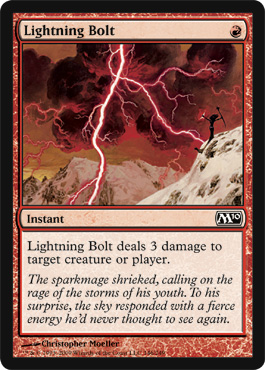
Magic: the Gathering is a trading card game emerging from the 1990's that was heavily inspired by high fantasy, which was best represented by role-playing games such as Dungeons and Dragons. Utilizing mechanics similar to a game of chess mixed with simple math, Magic pulled players into the realm of the game with both high quality artwork and a compelling story line.
 A unique issue arose within card design: how to integrate the story of the game seamlessly with the physical cards. The artwork was one half of the solution, but the addition of text at the bottom of the card (referred to as Flavor Text) really brought story into the physical card game.
A unique issue arose within card design: how to integrate the story of the game seamlessly with the physical cards. The artwork was one half of the solution, but the addition of text at the bottom of the card (referred to as Flavor Text) really brought story into the physical card game. 
Flavor text is so important to the game, that several staff are tasked with adding flavor text to new cards in order to integrate them into the story line.
If you guys are interested in reading more flavor text examples, here's a link to a top 20 compilation written by the company that makes the game!
https://magic.wizards.com/en/articles/archive/uncharted-realms/top-20-flavor-text-2013-08-06
Couple of questions for you:
1. After being shown Lightning Bolt as both a card originally devoid of flavor text and one with some added later, how does the flavor text enhance your opinion of the card altogether despite not knowing much about what the card does?
2. Based on the examples of flavor text in the link I gave, how does the flavor text portray the characters involved in the following artwork? Does this count as ekphrastic in a way or does the text emerge separate of the artwork?
Hi Matt:
ReplyDeleteThis entry made me think of the Italian writer, Italo Calvino, one of the great authors of the 20th century. He wrote a series of stories called The Castle of Crossed Destinies inspired by tarot cards randomly chosen from the deck. In fact, much of his work was created using games of chance. He was a member of Oulipo, a group of avant-garde writers who introduced games and chance into their writing. They were influenced by the surrealists before them. The French have all the best art movements.